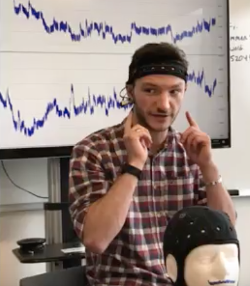by Robin Spring, Associate Professor
The advertising field moves fast and is constantly evolving. The proliferation of media channels, digital opportunities, new technology, and innovative evaluation methods make continual learning in this industry crucial. Understanding and leveraging emerging technology can assist in developing strategic messages that have the intended impact. Gone are the days of creating messages on a hunch. Neuromarketing leverages neuroscience to study a subject’s non-conscious physiological functions through biometric testing for the purpose of understanding reactions to stimuli; highly useful in crafting strategic messaging.
Biometric testing is being used more frequently now by brands and their agencies to determine the efficacy of a commercial message relative to consumer decision making. When millions of dollars of ad expenditures are on the line, it’s vital to get the message right. As we know from communication studies, messages are encoded by the sender and decoded by the recipient. Sometimes, messages are understood differently than what was intended by the sender. (Think of a time you’ve had a miscommunication!) Biometric testing adds a layer of confidence by providing scientific data on how people will likely react to an advert based on research.
Neuromarketing techniques can aid in crafting meaningful messages with positive sentiment and higher recall while averting miscommunication by understanding human reactions. Biometric data can be gathered using a variety of tools:
- Electroencephalogram (EEG): Measures the electrical activity of the brain which can indicate engagement, cognitive workload and motivation or avoidance. Data is collected via electrodes applied to the scalp.
- Electrocardiogram (ECG/EKG): Records the electrical signal from your heart through electrodes placed on the chest to record the heart’s electrical signals. Heart rate can indicate the excitement, emotion and intensity of a reaction to a stimulus.
- Electromyography (EMG): Gathers muscle movement data via sensors that can be examined in relation to a subject’s emotions.
- Eye Tracking: Eye movements are captured via a small camera much like you may have for an online meeting via Zoom. Eye tracking helps content creators understand what elements are attracting visual attention and what is being ignored. Eye Tracking data can be displayed individually, showing what elements a subject is looking at, for how long and in what order. Additionally, aggregate data from multiple subjects can be displayed in a heat map to indicate the primary areas of interest. This information is helpful in design, layout and editing decisions.
- Facial Expression Analysis or Facial Action Coding (FAC): Facial expressions are recorded using the same camera that captures eye movement. Facial Action Coding is based on the seminal work of Paul Ekman. Dr. Ekman studied facial expressions in 75 countries to understand if facial expressions are universal. (Spoiler alert: Yes, many are.) In fact, Discrete Emotion Theory posits that there are a small number of fundamental emotions. Ekman’s painstaking work of tracking activation of 42 facial muscles and their correlating emotion has now been automated. Facial expressions are now easily tracked and can indicate positive and negative emotional reactions to stimuli. Arousal intensity is also recorded. Understanding what emotions are triggered at specific times in a video, for example, can assist with creating and editing content.
- Galvanic Skin Response (GSR): Measures non-conscious thermoregulation (body temperature) and skin conductance of sweat. We are looking at “emotional sweating” that indicates a response via the involuntary autonomic nervous system. Small sensors velcroed to the fingers register emotional arousal and intensity to a stimuli, or advertisement. GSR arousal can indicate emotional relevance in specific areas of a video for example. This information can be combined with the facial expression FACS tool to discern whether arousal is positive or negative. This information helps researchers determine the intensity and sentiment to an advertisement and if any changes should be considered.
Did you know the GVSU Advertising/Public Relations program has a Biometrics Lab? Although we don’t have access to EEG, EKG and EMG technology, our Advertising/Public Relations program is fortunate to have eye tracking, facial expression coding and galvanic skin response capabilities. Here’s an example of a student created advertisement tested in our own biometric lab and a summary of the results:
To be certain, the strategic communications fields have evolved in many ways. Leveraging the science of biometrics advances the capability to understand how humans feel about the messages they receive, thus providing valuable insight to those creating them. Developing inspirational, impactful communication relevant to the intended audience is the goal.
If you are interested in participating in an educational research study, feel free to add your contact information tothis list. Though no studies are running currently, there will be opportunities in the future. Our lab tools are licenced via iMotions, a collaborative group of researchers who pride themselves in “unpacking human behavior.” If you are interested in learning more about biometrics, there is a plethora of information on the iMotions website.





Hi Tim,
This looks good, but one photo is misplaced.
The larger photo labeled, “Graph indicates engagement, surprise, smile +/- sentiment to an advertisement” should appear as the last photo, under the paragraph that starts: Did you know Ad/PR program has a biometric lab?
At the end of that paragraph, it says: Here’s an example of a student created advertisement tested in our own biometric lab and a summary of the results: The photo should appear right after that.
Other than that, looks great, thanks!
Best,
Robin
From: enLIGHTen
Reply-To: enLIGHTen
Date: Monday, November 15, 2021 at 1:12 PM
To: Robin Spring
Subject: [New post] Biometric Testing: Uncovering Hidden Reactions to Advertisements
gvsuapr posted: ” by Robin Spring, Associate Professor The advertising field moves fast and is constantly evolving. The proliferation of media channels, digital opportunities, new technology, and innovative evaluation methods make continual learning in this industry cr”
LikeLike